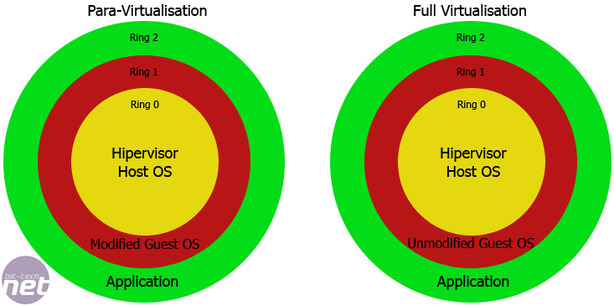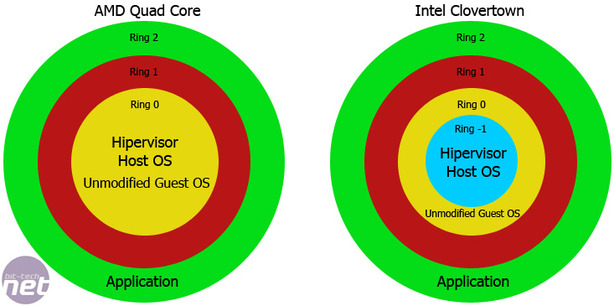
Improved Virtualisation is no longer a virtual reality.
One of the major improvements to AMDs quad core architecture is its updated virtualisation technology. The increased use of virtualisation was partially premièred by the Apple crowd wanting to run a Windows operating system for compatibility's sake. However somewhat ironically, with the haemorrhaging defect from Vista to other OSes like Ubuntu or OSX, but still having to pander to Vista for DirectX 10, virtualisation will probably be an addition that gets more attention from more people in the future.Typically an x86 architecture supports different classes of operation privileges, providing it a certain level of access to the system. These are usually referred to as rings and concentrically expand as you decrease the level of core system access, so software running in an inner ring exercises control over software in outer rings.
Naturally an OS takes control of the innermost ring and has complete subsystem control, with user applications being layered over the top. Traditionally, x86 processors cannot run both host and guest OS in the innermost, Ring 0, because of a natural conflict in accessing system resources.
There are several types of Virtualisation, but fundamentally it comes down to being software enabled and hardware enabled. Software traditionally allows for more flexibility but hardware is much faster. With the greater development of virtualisation, a common style of system access is used so it’s easier to design hardware to make use of this, accelerating it.
Para-virtualisation in a software environment uses a modified Guest OS that has been recompiled to sit in a Ring (Ring 1 for example) just above the Host OS. This is limited to open source OS’ that can be specifically recompiled for this application, as it has to interact with the Host OS which handle all its device requests.


AMD has additionally included other improvements into its quad core architecture as well, mostly based around its integrated memory controller which allows for Device Exclusion Vectors (DEV) and Tagged Translation Look-aside Buffer (TLB).

MSI MPG Velox 100R Chassis Review
October 14 2021 | 15:04








Want to comment? Please log in.